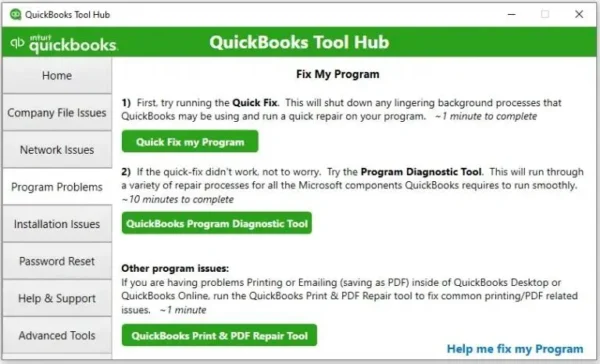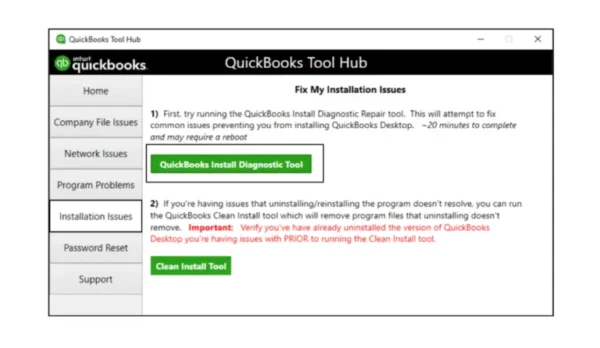Is QuickBooks error 6010 flashing on your screen? Many users have encountered this error when they open the server and try to access the data file to create a backup. Numerous problems may arise along with this error, including the File Doctor glitch, the database server manager saying there are no files, etc. The primary reason behind this company file error is that the file is hosted on another computer that is not the server. In this guide, we have mentioned all the reasons that trigger QuickBooks error 6010 100 and solutions you can implement to fix it in no time.
Are you unable to fix QuickBooks error 6010? Let our experts step in and help you remove the error code effectively. Call us at +1.855.738.2784.
Reasons for QuickBooks Error 6010 100
Here are all the causes behind the 6010 error in QB, which can cause trouble accessing the data file:

QuickBooks error code 6010 100
- An outdated or discontinued QuickBooks Desktop version.
- Difficulty accessing the company file arises due to damage or the need for repair.
- Corruption of configuration files like Network Descriptor and Transaction Log files can result in this 6000-series error.
- If the QuickBooks Database Server Manager is problematic, you get QuickBooks error code 6010 on local or network setups.
- Incorrect hosting settings and network setup can cause problems opening the company file.
- Firewall restrictions blocking QuickBooks access to the company file.
- Incorrect or insufficient folder permissions can lead to this error.
- A corrupt QuickBooks installation may be the problem.
- Damage to the location where the company file is saved.
- Interference from third-party applications and background processes.
- Exceeding file path limitations set by QuickBooks can lead to this error.
- If you have hosted the company file on any system other than the server, the error 6010 may appear.
General Troubleshooting for QuickBooks Error Code 6010
Here are the top fixes to try when you get QuickBooks error code 6010 100:
Measure 1: Update QuickBooks
If you’re using an outdated version of QuickBooks Desktop, it’s crucial to update to the latest release promptly. Outdated software may encounter issues like QuickBooks error 6010, arising from software glitches, security vulnerabilities, or the absence of bug fixes. Follow these steps to update QuickBooks Desktop and eliminate any risk associated with this code:

Update QuickBooks Desktop
- Close any open company files and the QuickBooks Desktop window.
- Press the Windows key to access the Start menu.
- Type “QuickBooks Desktop” and right-click when the application’s icon appears.
- Select “Run as administrator” from the drop-down menu after right-clicking QB.
- When you arrive at the No Company Open screen, navigate to the Help menu.
- Choose “Update QuickBooks Desktop.”
- Access the Options tab, then check the “Mark All” option.
- Tap Save to lock your choices and switch to the Update Now tab.
- Mark the checkbox named “Reset Update.”
- Click “Get Updates” when you’re prepared.
- After updating QuickBooks Desktop, close and reopen the application.
- Choose “Yes” so the updates get applied.
- Once the QuickBooks update installation is finished, restart your system.
Measure 2: Use QuickBooks File Doctor
QuickBooks Tool Hub offers an effective tool for addressing company file issues. It is none other than QuickBooks File Doctor which is a vital component of this tool. When facing the QuickBooks Desktop error 6010, which prevents you from opening the company file, utilize this tool by following these steps:
Part 1: Download And Install QuickBooks Tool Hub (If You Haven’t Already)
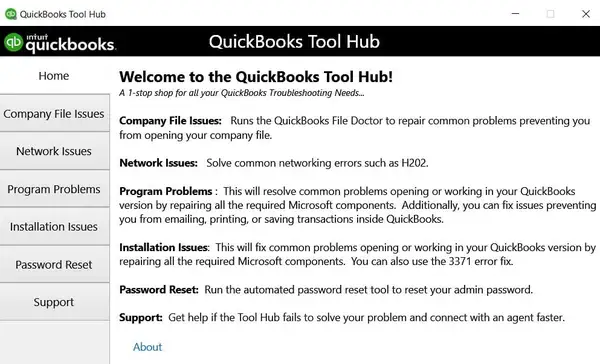
QuickBooks Tool Hub
- Close QuickBooks and any on-screen company files, then access your web browser.
- Download QuickBooks Tool Hub to your PC from the official Intuit website before proceeding.
- Click the download link and save the QuickBooks Tool Hub installation files in an easily accessible location.
- After the download is complete, go to the saved location, get the files, and double-click QuickBooksToolHub.exe to start the installation.
- Follow the on-screen InstallShield instructions, including accepting the License Agreement, to complete the installation without issues.
- After installation, you can start using QuickBooks Tool Hub.
Part 2: Use QuickBooks File Doctor
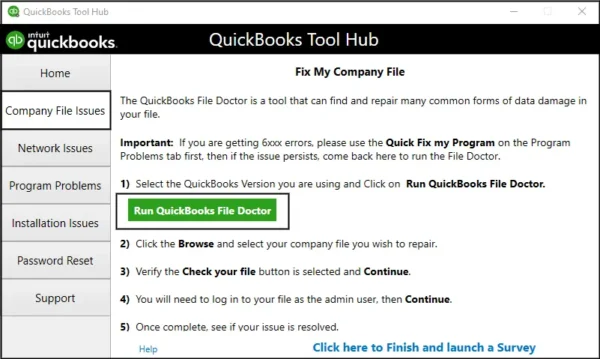
QuickBooks File Doctor
- Launch the QuickBooks Tool Hub after the installation is complete.
- Click Company File Issues within the QB Tool Hub.
- Tap “Run QuickBooks File Doctor.”
- Upon launch, locate and hit the company file you want to scan. If it’s not in the drop-down list, use the Browse option to look for it manually.
- Select ‘Check your file,’ then hit the Continue option.
- Enter your QuickBooks admin password when QB requests, and then hit Next.
Measure 3: Access QuickBooks with Windows Closed
QuickBooks automatically reopens any windows that were left open when closing your company file. Suppose you encounter an unrecoverable error, like QB error 6010, during startup, especially when dealing with large reports or automatically opening multiple windows. In that case, you can resolve the company file by opening your file with all windows closed using the following steps:
- Launch QuickBooks Desktop.
- In the “No Company Open” window, choose your company file.
- Hold down the ALT key on your keyboard and then select “Open.” Keep holding ALT until the file opens. If prompted to sign in, release ALT, enter your password, and then press and hold ALT again before selecting OK.
Measure 4: Change the QB User
Attempt to access your company file using a different QuickBooks user with the following steps when the QuickBooks error 6010 arises:
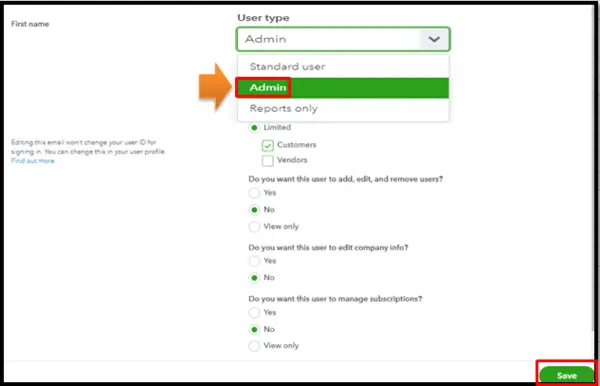
Change the QB User
- Navigate to the “Company” menu and hit “Set Up Users and Passwords,” then select “Set Up Users.”
- For Enterprise users: Access the “Company” menu, select “Users,” and then hit “Set Up Users and Roles.”
- Select “Add User…,”input the new username and password, and click “Next.” Avoid using the problematic username.
- Customize the user settings as needed and click “Finish.”
- Hit the “File” menu and click “Close Company/Logoff.”
- Sign in to the company file using the credentials of the newly created user.
- If the new user works, delete the user causing issues and recreate them.
Measure 5: Create a New Windows Admin
Ensure you have admin user credentials in Windows to give you enough rights to access the company file without errors:
- Access the Start menu, navigate to Settings, then choose Account.
- Click on Family & other users.
- Under the Other Users section, go with Add someone else to this PC.
- Click I don’t have this person’s sign-in information.
- Now, go with Add a user without a Microsoft account.
- Enter the name of the new account and select Finish.
- For security, it is recommended to assign a password to the new account.
- Choose the newly created account and then Account Type.
- Click Administrator and click
Case 1: Eliminating QuickBooks Error Code 6010 100 in a Network Setup
Here are the troubleshooting methods for addressing QB error code 6010 when accessing the company file saved on the server or another system:
Solution 1: Verify Hosting Settings for Workstations
To initiate the resolution of error 6010, let’s delve into the hosting settings on all workstations to confirm that multi-user access is not enabled anywhere except on your server system:
- Open QuickBooks on your workstation and tap the keyboard’s F2 key.
- Scroll down to the Local Server Information section when the Product Information screen launches.
- Confirm that hosting is turned OFF.
Solution 2: Rename ND And TLG Files, then Use QuickBooks Database Server Manager
If your configuration files are corrupt, QuickBooks error code 6010, 100 may appear. The Network Descriptor (.ND) and Transaction Log (.TLG) files play a key role in configuration, facilitating access to company files across a network. Consequently, renaming these files is a standard procedure for addressing and resolving the 6010 error:
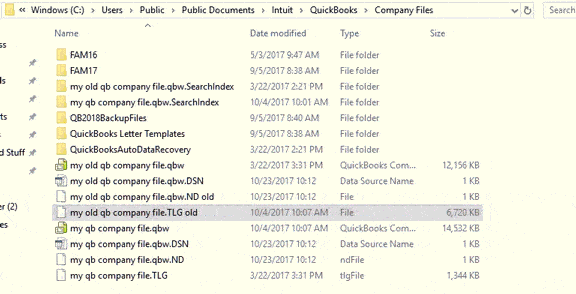
Modify the Names of the .TLG & .ND Files
- Launch the folder where you have kept the company files safely.
- Identify files with .ND and .TLG extensions matching your company file name (e.g., MMCompany.qbw.nd and MMCompany.qbw.tlg).
- Right-click each ND and TLG file, hit “Rename,” and add .OLD at the end (e.g., MMCompany.qbw.nd.old and MMCompany.qbw.tlg.old).
- Re-launch QuickBooks and try one more time to access your company file.
After renaming the configuration files, we’ll run the QuickBooks Database Server Manager (QBDBSM) that serves as the host for your QuickBooks company files. After changing the name of the .ND and .TLG files, you can reboot it and scan the QuickBooks files.
This process begins by launching the QuickBooks Database Server Manager through the QuickBooks Tool Hub, which follows the steps below:

QuickBooks Database Server Manager
- Open the Tool Hub, turn to Network Issues, and select QuickBooks Database Server Manager.
- If QuickBooks is not yet installed on your server, ensure to install it.
- In the QuickBooks Database Server Manager, choose Start Scan, especially if your company file(s) are visible. If not, manually access your company file and click Start Scan.
- Subsequently, reopen QuickBooks and attempt to open your company file again.
- If QB error 6010 persists, proceed to Technique 3. You can also directly access the QuickBooks Database Server Manager from the Start tab. Simply search for it in the Start menu and tap the tool.
Solutions 3: Launch a Sample Company File
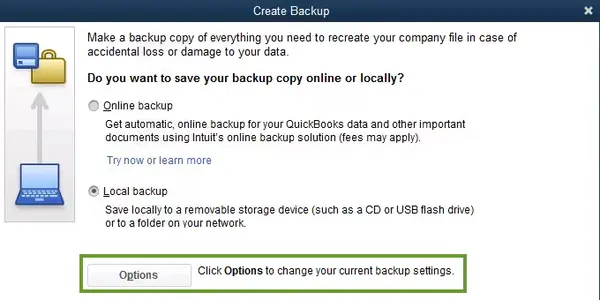
Copy the Company File to the Desktop
- When you reach the No Company Open window, choose the “Open a Sample File” option and select any sample file from the provided list.
- If the sample file opens without encountering errors, proceed to the subsequent solution for QuickBooks error code 6010.
- If issues arise with the sample files, repair your installation files using the Quick Fix My Program and the QuickBooks Install Diagnostic Tool available in the QB Tool Hub.
- Quick Fix My Program:

Quick Fix My Program
- Open the QuickBooks Tool Hub by either double-clicking the icon or navigating through the Start menu > Programs.
- Select “Program Problems.”
- Click “Quick Fix My Program.”
- Once the tool ends the QuickBooks repair process, open QuickBooks Desktop and access your data file.
- QuickBooks Install Diagnostic Tool:

QuickBooks Install Diagnostic Tool
- Access the QuickBooks Tool Hub.
- Click on “Installation Issues.”
- Choose “QuickBooks Install Diagnostic Tool.”
- Allow the diagnostic tool to address installation problems and then restart your PC.
- Open QB Desktop and launch your data file to check the error 6010 status.
- Quick Fix My Program:
Solution 4: Copy the Company File to The Desktop
In this troubleshooting step, we will determine whether QB error 6010 is associated with the damaged location of the company file. To assess this, we need to create a copy of the company file and paste it to the desktop. Then, attempt to open it from there. This evaluation will yield the following insights:

Copy the Company File to the Desktop
- If the file opens successfully:
- The original company file location is corrupt.
- If the file does not open:
- It might be stored within multiple folders, exceeding the file path limitations.
- If errors persist:
- Your company file has underlying damage and requires repair or backup recovery.
Conduct this test by following these instructions for copying and pasting your company file to the desktop:
- Locate and open the secure folder containing your company files.
- Right-click the .QBW company file and select the Copy option.
- Come back to the desktop, right-click on any blank area of the screen, and choose the Paste option.
- Access QuickBooks while pressing the Ctrl key to launch the No Company Open window.
- Click “Open or restore an existing company.”
- Navigate to your desktop, look for your company file, and open it.
If the error 6010 persists, proceed to Technique 5. However, if the file opens in the new location, use it as a permanent place and ensure you always open it from here.
Solution 5: End QB Tasks
This solution for QuickBooks error 6010 centers around terminating all active QuickBooks processes through the Task Manager to address potential background clashes:
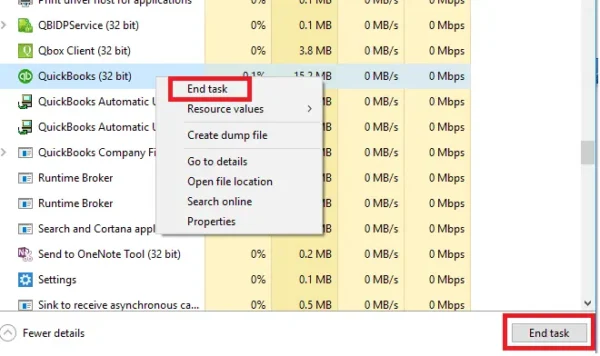
End QuickBooks Processes from Task Manager
- Log in to your server PC with Administrator usernames and passwords.
- Launch the Task Manager using the keyboard shortcut Ctrl+Shift+Esc.
- Attempt to display Processes for all users and click on Users.
- Now, terminate all the QuickBooks processes (QBW32.EXE, qbupdate.exe, and QBDBMgr.exe) by right-clicking on them and selecting the End Task option.
- You should now be able to access the QuickBooks company file in multi-user mode.
If the error 6010 persists, proceed to Technique 6.
Solution 6: Manage the Folder Permissions Manually
If the directory where your file is stored doesn’t have the correct permissions, you might encounter the 6010 error in QuickBooks Desktop. If you’re encountering company file inaccessibility, adjust the folder permissions using the following steps:

Verify the Folder Permissions Manually
- Access File Explorer by clicking the Windows icon and launching the Windows Start menu.
- Right-click the folder, keeping the company files secure, and select the Properties option.
- Choose Security, then click Advanced.
- Hit QBDataServiceUserXX and select the Edit button.
- Click Allow and provide the following permissions:
- List Folder/Read Data
- Write Extended Attributes
- Read Attributes
- Traverse Folder/Execute File
- Create Files/Write Data
- Read Extended Attributes
- Write Attributes
- Create Folders/Append Data
- Read Permissions
- If your permissions are incorrectly configured:
- Right-click the company file folder > access Properties.
- Access Security, then hit the Edit
- Click QBDataServiceUserXX, click Full Control, and then proceed with the Allow
- Click Apply and OK.
- Try opening your file and verify if error 6010 persists.
Solution 7: Lift the Antivirus & Firewall Blocks
Experiencing errors like 6010 while attempting to open the company file may result from firewall and antivirus software restrictions on specific QuickBooks programs or files. To address this issue, we recommend managing the firewall ports and establishing exceptions in the antivirus software. We want you to note that Intuit does not develop antivirus programs, you should consult your antivirus software vendor for specific instructions on configuring these exceptions.
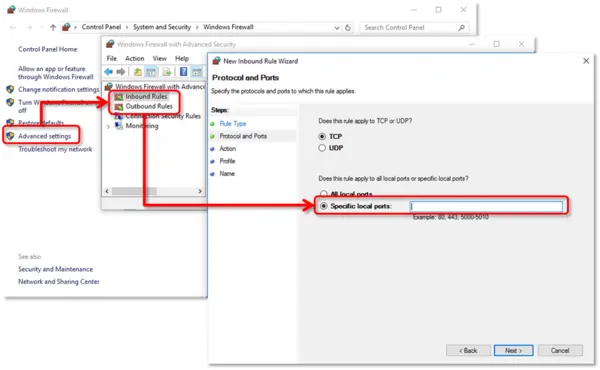
Configure Firewall Ports
Use the steps below to modify your firewall ports and create exceptions for QuickBooks:
- Open the Start menu using the Windows logo on the keyboard.
- Access “Windows Firewall” through the search area in the Start menu.
- Tap Advanced Settings.
- Right-click Inbound Rules and click New Rule to create one.
- Hit Port and proceed to the next step by clicking Next.
- Tap TCP.
- Use the required ports for your specific QuickBooks Desktop version in the Specific local ports area.
- After entering the port number where required, click Next.
- Again, tap Next after clicking Allow The Connection.
- Mark all profiles as asked, then select the Next button.
- Create a rule. Assign a name.
- Click Finish.
- Repeat the same thing for Outbound Rules, replacing Inbound with Outbound in Step 4.
Case 2: Troubleshooting QuickBooks Error Code 6010, 100 When You Access The File in a Single-user Mode
If you encounter the QuickBooks 6010 error on the computer where QuickBooks is installed (local access), you should follow the troubleshooting steps outlined below:
Step 1: Rename ND And TLG Files
Follow the same steps as mentioned in Technique 2 to rename the configuration files and correct the corruption.
Step 2: Access a Sample Company File
Follow the steps mentioned in Technique 3 in detail.
Step 3: Copy the Company File to the Desktop
Follow the same steps as mentioned in Technique 4 in detail.
Step 4: Restore the Backup Company File
Verify if the issue lies with your current company file (.QBW) by restoring a backup copy. If an error arises while you restore, follow these steps:
- Confirm that your computer is not hosting.
- Open your company file.
- Navigate to File, then choose Utilities.
- If “Stop Hosting Multi-User Access” is there:
- Tap “Stop Hosting Multi-User Access.
- Select “Yes” in the “Stop hosting multi-user access” prompt.
- Select “Yes” when the “Company file must be closed” window arises.
- Ensure that the path to your company file is not longer than 210 characters.
- Arrive at the location of your company file.
- Copy the path from the address bar.
- Paste this into Notepad and count the characters and spaces. For example: C:Documents and SettingsAll UsersDocumentsIntuitQuickBooksSample Company FilesQuickBooks 2022Sample_company_file.qbw is 125 characters.
- Attempt to restore your company file again.
- If the error 6010 persists, proceed to Step 5.
Step 5: Use Auto Data Recovery
When you face complications in restoring a backup caused by damage in your company file, you can rely on Auto Data Recovery to recover your company file and address the QuickBooks error code 6010.
Below are the steps to recover recent transactions using the original .TLG file and .QBW.adr file:
- Create a new folder named QBTest on your desktop by right-clicking and selecting New > New Folder.
- Open the folder where your company file is located, which can be found on the Product Information screen (press F2 or Ctrl+1).
- Locate the .tlg file in your company file’s folder (with the same name as your company file).
- If you can’t find the .tlg file, show file extensions by opening File Explorer, selecting Organize, then Folder and Search options, and unchecking “Hide extensions for known file types.”
- Copy the corresponding .tlg file of your company file and paste it into the QBTest folder on the desktop.
- Access the QuickBooksAutoDataRecovery folder, located in the same place as your company file.
- Copy the .QBW.adr file and paste it into the QBTest folder, resulting in both .QBW.adr and .tlg files in the QBTest folder.
- Rename the .QBW.adr file in the QBTest folder by removing .adr at the end of the file name.
- Open QuickBooks and the company file stored in the QBTest folder, then use your account register to verify all transactions.
- Select File, then Utilities, and Verify Data to scan the data integrity of the recovered file.
- If the copy of the company file is satisfactory, move the damaged company file to a different location and transfer the copy from QBTest to the original location.
For recovering recent transactions excluding the last 12 hours:
- Make a new folder named QBTest on your desktop.
- Open the folder where your company file is stored and locate the QuickBooksAutoDataRecovery folder.
- Access the .TLG.adr and .QBW.adr files with the exact name of your company file.
- If you can’t identify the .TLG.adr and .QBW.adr files, show file extensions following the steps mentioned earlier.
- Create a copy of the .TLG.adr and .QBW.adr files and paste (Ctrl+V) them into the QBTest folder.
- Remove .adr from the file names in the QBTest folder, resulting in .qbw and .tlg files.
- Open QuickBooks and the company file from the QBTest folder, then use your account register to verify all transactions.
- Check the data integrity of the recovered file by selecting File, Utilities, and Verify Data.
- If the copy of the company file is satisfactory, move the damaged company file to a different location and transfer the copy from QBTest to the original location.
Conclusion
You should now be able to fix QuickBooks error 6010 after going through our comprehensive blog. We have covered the details of this error with the reasons and solutions. Although we hope this guide works for you, we recommend you call our QuickBooks dedicated specialists if it doesn’t. Call our toll-free number 1.855.738.2784 and ensure proficiency in fixing the issues.
FAQs
What is the instance where QuickBooks error 6010 appears?
In QuickBooks Enterprise Pro 2021, the error occurs after a server reboot for patch installation on a Windows 2012 server. Despite the absence of precautions like ensuring user exits and manual backup, QuickBooks refuses to open the data file, presenting error code -6010 -100. Subsequent server reboots lead to the disappearance of the data file, and restoration from a backup becomes necessary. Even after restoration, issues persist, such as the inability to switch to Multi-User Mode if opened in Single User Mode first. These challenges cause a fear about server reboots and the use of Single User Mode by the accounting staff.
What are the steps to restore the backup and fix QuickBooks error 6010?
Attempt restoring the backup and setting it as your primary company file with these steps:
Open the QuickBooks program and then the File menu.
Choose Open or Restore Company from the File drop-down list.
Tap Restore a backup copy > Next.
Choose Local Backup, then proceed with Next.
Use Browse to locate the backup company file on the PC, often named SSTCompany.qbb.
Click a folder to store the restored company file and hit Open. Note: Exercise caution to prevent data overwrite risks, especially if the backup is in the same folder as your existing company file.
To ensure no overwriting, consider renaming either the existing company file or the backup, ensuring unique names. Alternatively, you can save the backup in an entirely new folder.
Once the backup file is prepared for use, click Save. If prompted about potential data overwriting, choose the option that is the best for your preference, ensuring careful avoidance of unintended overwrites.
The newly restored company file is now ready for your use.
How do I configure firewall and antivirus port exceptions for the QuickBooks programs to resolve the error 6010?
Make sure there are Windows Firewall exclusions for QuickBooks programs with the following steps:
Open the Start menu with the help of the Windows logo on your keyboard.
Access “Windows Firewall” through the search section in the Start menu.
Click on Advanced Settings.
Right-click the Inbound Rules option and create a New Rule by tapping this option.
Tap Program, then proceed by selecting Next.
Click This Program Path and choose Browse.
Select any executable file, then hit Next.
Click Allow the Connection > Next.
If prompted, choose all profiles, then Next.
Create and assign a name for the rule.
Repeat the precise steps to add exceptions for QB programs in Outbound Rules.

Edward Martin
Edward Martin is a Technical Content Writer for our leading Accounting firm. He has over 10 years of experience in QuickBooks and Xero. He has also worked with Sage, FreshBooks, and many other software platforms. Edward’s passion for clarity, accuracy, and innovation is evident in his writing. He is well versed in how to simplify complex technical concepts and turn them into easy-to-understand content for our readers.


